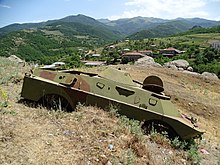Draft:Karintak operation
 | Draft article not currently submitted for review.
This is a draft Articles for creation (AfC) submission. It is not currently pending review. While there are no deadlines, abandoned drafts may be deleted after six months. To edit the draft click on the "Edit" tab at the top of the window. To be accepted, a draft should:
It is strongly discouraged to write about yourself, your business or employer. If you do so, you must declare it. Where to get help
How to improve a draft
You can also browse Wikipedia:Featured articles and Wikipedia:Good articles to find examples of Wikipedia's best writing on topics similar to your proposed article. Improving your odds of a speedy review To improve your odds of a faster review, tag your draft with relevant WikiProject tags using the button below. This will let reviewers know a new draft has been submitted in their area of interest. For instance, if you wrote about a female astronomer, you would want to add the Biography, Astronomy, and Women scientists tags. Editor resources
Last edited by Citation bot (talk | contribs) 2 seconds ago. (Update) |
| Karintak operation | |||||||
|---|---|---|---|---|---|---|---|
| Part of First Nagorno-Karabakh War | |||||||
 Destroyed Azerbaijani military vehicle , Karintak | |||||||
| |||||||
| Belligerents | |||||||
|
[a] |
[b] | ||||||
| Commanders and leaders | |||||||
|
|
| ||||||
| Casualties and losses | |||||||
| 90 [1][2][3] | |||||||
On January 25 and 26 1992, an Azerbaijani-led operation was carried out with the aim of liberating the village of Karintak, near Shusha, from the control of the Armenian-allied Republic of Artsakh.[4][5][6] It started at 20:00 on January 25, 1992, and ended unsuccessfully on the evening of January 26. Former Minister of Defense, Major General Tajaddin Mehdiyev directly led the operation. Three volunteer divisions of the newly formed Azerbaijan Army and fighters of the defense camp of Shusha took part in the operation.
As a result of tactical mistakes, lack of communication between the groups, the spread of the operational secret and the betrayal of the guides, the Azerbaijani platoons entering Karintak from the direction of Nəbilər village were ambushed by Armenian forces and completely destroyed. Several platoons that entered the village were able to retreat with significant losses.The battle lasted just over 12 hours. According to official information, the Azerbaijani Army lost more than 90[7] people in the Karintak operation.
Battle
The operation involved 200 soldiers from the Shikhov battalion. Former Defence Minister Tajaddin Mehdiyev was in charge of the operation. Self-defense units from the nearby villages of Shosh, Syznek, Skhnakh, Karmir-gyukh were sent to help the residents of Karintak. All work was carried out at night, and during the visible time of day the village lived an ordinary life. Karintak was clearly visible from Shushi, any movement in the village, any preparatory work would have been noticed.
According to the first plan, the platoon was to pass through the village of Nebiler, climb up to the height of Harutyunagomer, and from there cut the road that leads from Karintak to the village of Signakh. According to the second plan, the platoon was supposed to block the road leading from Karintak to the village of Shushakand.
Unfavourable weather conditions, lack of communication between the platoons, leaking of secret information about the operation and betrayal of the guides led to the failure of the operation. The platoon which reached Karintak was ambushed. The other platoons also suffered losses and were forced to withdraw from the area.The total loss of the Azerbaijani Army during the failure of the operation was 90 men.[8]
References
- ^ Nagorno-Karabakh Autonomous Oblast (NKAO) until 1991.
- ^ Azerbaijan Soviet Socialist Republic (Soviet Azerbaijan) until 1991.
- ^ https://soyqirim.az/en/link/11921.
- ^ https://caliber.az/en/post/219338/.
- ^ https://www.kavkaz-uzel.eu/blogs/485/posts/10475.
- ^ Black Garden: Armenia and Azerbaijan Through Peace and War. Thomas De Waal (published 337). 2003. pp. 314–317. ISBN 9780814719459.
- ^ Daily Report: Soviet Union. The Service. 1991.
- ^ Balayan, Vahram (2005). Artsakh History: From Time Immemorial Up to Our Days. Zangak-97. ISBN 978-99930-2-078-3.
- ^ Gore, Patrick Wilson (2008). 'Tis Some Poor Fellow's Skull: Post-Soviet Warfare in the Southern Caucasus. iUniverse. ISBN 978-0-595-48679-3.
- ^ "Azerbaijan marks 32nd anniversary of Dashalti operation | Caliber.Az". caliber.az. 2024-05-04. Retrieved 2024-05-04.
